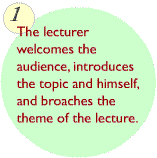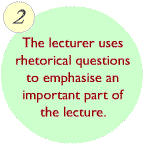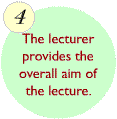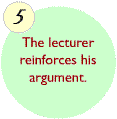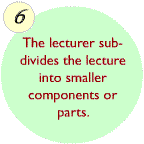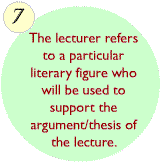Marker Language in a Lecture Transcription
To find out more about the sort of ‘marker language’ used in lectures, have a look at this lecture transcription from the opening part of a lecture by Dr. Gerard Sharpling called ‘Key Words in Modern French Theatre’, given at the University of Birmingham (French department).
Transcription of lecture ‘Key words in modern French theatre’ |
|
|
OK, can we fairly shortly make a start, please? OK, a very warm welcome to the year one drama option, nice to see so many faces, quite surprised to see such a big group, actually, my name is Gerard Sharpling and I work in the French department and the Modern Languages Unit here at the University of Birmingham, and also at Warwick University, so it's a great pleasure to be here this morning to speak to you about 20th century drama. I'd like to begin now by just giving you some idea of some of the things I'm going to be talking about in this lecture, and if we briefly refer to the first schema which is on the the board, there's no need to copy this down, actually, but if you notice on this schema, it's fairly basic and fairly er inaccurate view really of what a theatrical text actually consists of. In the particular schema which you have, we begin with the actual author who writes the play, and this obviously in turn leads to the text. the characters within the text speak using language, and that actually is received by the audience, so it's a pretty sort of unilinear, fairly sort of uninteresting g account of what actually happens in twentieth century plays.[1]
Now, there are some problems with this, and one of the main problems actually is that some of the words are very (can you hurry up and sit down as soon as possible please) some of the words are quite overused and not very accurate in terms of what actually happens within a play. For example, looking at the author, who actually writes the play? Is it the author or the director?[2] So, we have a problem of authorship, er, and we don't really know who is responsible for the play as we see it. Secondly,[3] er, how can the director, if we assume that the author is replaced by the director, how can the director remain faithful to the, the author's intentions, that's the second sort of big problem with this, actually.
Thirdly is the problematic status of language. So one of the big problems there is that verbal language or words are one way of conveying meaning in a play, but as you will know from your own experiences of 20th century plays, there are many other ways of er producing communication which don't actually depend on language, so you have for example mime, gesture, stage effects, that kind of thing, so to view verbal language as a sole means of communication in a play is quite inaccurate in the sense that directors and playwrights will actually come across many other ways of dealing with communication. Finally, and perhaps the most problematic area of this schema is the er the audience. The problem with this diagram is that the audience is right at the bottom, and is seen as a passive and very quiet sort of recipient of the drama. In other words, when you go to see a play, the audience basically receives the spectacle, and presumably interprets the action in some way, but one of the problems of this is that it denies the very active, participatory role of the audience in the play itself. So these are some rather major problems with 20th century drama, if we look at it simply in this very basic way.
What I'd like to propose this morning, and the aim of the lecture, is to try to revise this very fairly monotonous scheme into a slightly more dynamic picture which could look something like this (see powerpoint).[4]
So you have a kind of reciprocal relationship between director and audience. The director is at the centre of the play, so the director will basically decide how the play is actually seen by the audience. Nevertheless, the audience will not receive the drama passively but will participate in the drama, ok, so if you like, the audience is challenged to actually respond to what the director does. At the sides of the diagram you have, for example, author and text. I'm actually putting author and text at the side of the diagram because this morning I hope to show that the author and the text of drama is actually secondary to the director and the audience. In other words, the kind of question which we should be asking is not what did Shakespeare intend to say, or what did Beckett intend to say when he wrote this piece of drama. Rather, what we ought to be looking at is how do we interpret what is actually said. I think that's quite a big difference which at first is rather disturbing, but secondly, becomes quite a lot more challenging when we're actually looking at drama.[5]
So my plan for this morning can basically be divided into four parts.[6] In the first part, I'd like to look in more detail at the rise in importance of the spectator in 20th century drama, with particular reference to French drama, of course. In the second part, I'd like to question the central area of language in drama, and I'd like to show that language means far more than just words. There's another kind of dramatic language which actually has far more importance. The third area I'd like to talk about is the rising importance of the director in drama during the the pre‑war and post‑war period. Again, I'm going to discuss this with particular reference to French drama, although a lot of what I say will be quite general also, and would obviously apply to plays in other nationalities, also. Finally, I'm going to have a very brief look at the word ‘character'. This will be the shortest of my sections. I haven't got a lot to say about it, but I want to try to challenge the way we look at character. Sometimes we tend to see characters as real people, real characters behaving in a very sort of true to life fashion. I want to try to challenge that a little bit, and hopefully to give you some ideas for when you study your subsequent texts.
One particular dramatist that I shall be referring to throughout the lecture is Antonin Artaud. Artaud was born in Marseilles in 1896, and he's quite a marginal figure in 20th century drama from some standpoints.[7] There are not many books written about him, but in fact, on of the books which I'm going to mention quite a lot this morning, le theatre et son double, is actually an attempt to subvert and to revise the rules of drama, and so, it lends itself very well to the revision that I'm going to propose this morning. So I shall devote probably about 10 minutes or so to each stage of the lecture, giving you some information that you'll be able to note down. Finally, I shall leave about five minutes before the end to allow time for any questions which you may have. Is the structure of the lecture clear to you? You're happy about how we're going from here?
|
|
|
|
